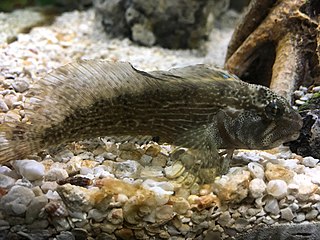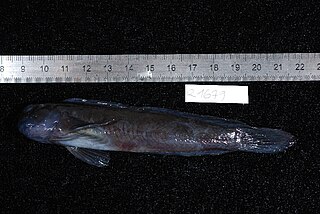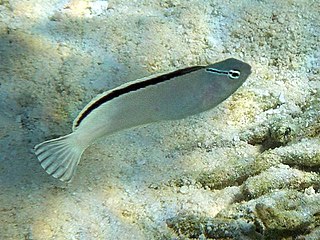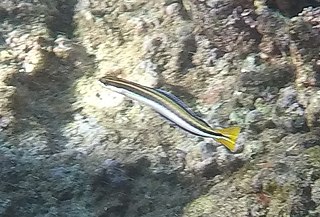
The Dussumier's halfbeak, also known as the slender garfish, lives in reefs and shallow lagoons. It is an Indo-Pacific species which is found from the Seychelles east to the Tuamotu Islands, north to Hong Kong and Okinawa and south to northern Australia. They form schools which are found near the surface of lagoons and seaward reefs. The longest known specimen was 38.0 cm in length. This species was described by Achille Valenciennes in 1847 with the type locality given as the Seychelles. The specific name honours the French voyager and merchant Jean-Jacques Dussumier (1792-1883).

Labeo dussumieri is fish in genus Labeo known to occur in west-flowing rivers of the Western Ghats. Earlier Sri Lankan population was considered as the same species as L. dussumieri, recent phylogenetic and physiological differences suggest that Sri Lankan population is a distinct species, Labeo heladiva..

Chasmodes bosquianus, the striped blenny, is a species of combtooth blenny found in the western Atlantic ocean, from New York to Florida. The specific name uses the suffix-ianus to denote "belonging to" and refers to the French naturalist Louis Augustin Guillaume Bosc (1759-1828), whose notes Bernard Germain de Lacépède used to base his description of this blenny.
Cirripectes springeri, Springer's blenny or the spotted eyelash blenny, is a species of combtooth blenny found in coral reefs in the western Pacific ocean. This species reaches a length of 10 centimetres (3.9 in) TL.The specific name honours the American ichthyologist Victor G. Springer of the United States National Museum who has worked extensively on blennies.

Enchelyurus kraussii, Krauss' blenny, is a species of combtooth blenny found in coral reefs in the western Pacific and Indian Oceans. This species grows to a length of 4.5 centimetres (1.8 in) SL. The specific name honours the German scientist, traveller and collector Christian Ferdinand Friedrich Krauss (1812-1890).

Hypleurochilus springeri, the orange-spotted blenny, is a species of combtooth blenny found in coral reefs in the Caribbean Sea. This species grows to a length of 5 centimetres (2.0 in) TL. The specific name honours the American ichthyologist Victor G. Springer.

Istiblennius is a genus of combtooth blennies found in the Pacific and Indian Oceans. The generic name is a compound noun composed of istio the Greek for "sail", referring to the high dorsal fin of the type species, Istiblennius muelleri, and blennius which is derived from a word for "mucus" and refers to the scaleless bodies that characterise the Blenniidae.

Istiblennius dussumieri, the streaky rockskipper, is a species of combtooth blenny found in coral reefs in the western Pacific and Indian Oceans. It is also commonly known as the Dussumier's rockskipper, streaky dussumier, or the Dussumier's blenny.

Meiacanthus smithi, the disco blenny, is a species of combtooth blenny found in coral reefs in the eastern Indian ocean. This species grows to a length of 8.5 centimetres (3.3 in) TL. It is also commonly known as Smith's fangblenny, Smith's sawtail blenny or Smith's harp-tail blenny. This species is also found in the aquarium trade. The specific name honours the South African chemist and ichthyologist James Leonard Brierley Smith (1897–1968) of Rhodes University in Grahamstown.
Mimoblennius rusi, the Rusi blenny, is a species of combtooth blenny found in the western Indian ocean. This species grows to a length of 4 centimetres (1.6 in) SL. The specific name is an acronym which stands for the J.L.B. Smith Institute of Ichthyology, Rhodes University where the holotype and paratypes are retained.

The longstriped blenny is a species of combtooth blenny found in the northeast Atlantic off Portugal, also known from the northern Mediterranean. This species reaches a length of 8 centimetres (3.1 in) TL. The identity of the person honoured by the specific name of this species was not specified but is thought to be the French painter and naturalist Jean Louis Florent Polydore Roux (1792-1833).
Petroscirtes thepassii, the Thepas' sabretooth blenny or the Thepas' fangblenny, is a species of combtooth blenny found in the western central Pacific ocean. This species reaches a length of 5.9 centimetres (2.3 in) SL. The specific name of this blenny honours the collector of the type, the military surgeon A.H. Thepass.

Plagiotremus goslinei, the biting blenny, Gosline's fangblenny, scale-eating blenny or the scale-eating fang blenny, is a species of combtooth blenny found in coral reefs in the eastern central Pacific Ocean. This species reaches a length of 6.3 centimetres (2.5 in) SL. The specific name honours the American ichthyologist William A. Gosline (1915-2002) of the University of Hawai‘i.
Rhabdoblennius snowi, Snow's rockskipper or the Snow blenny, is a species of combtooth blenny found in coral reefs in the Pacific ocean. This species reaches a length of 7 centimetres (2.8 in) TL. The specific name of this blenny honours the collector of the type, the missionary Benjamin Galen Snow (1817-1880).
Salarias patzneri, Patzner's blenny, is a species of combtooth blenny found in coral reefs in the western central Pacific ocean. This species can reach a length of 5.5 centimetres (2.2 in) TL. The specific name honours the Austrian ichthyologist Robert A. Patzner who worked on the genitalia of blennies and who shared specimens with Hans Bath.

The papillose blenny is a species of chaenopsid blenny found in the western Atlantic ocean. It can reach a maximum length of 4.5 centimetres (1.8 in) TL. The specific name honours the ichthyologist Charles C. G. Chaplin (1906-1991).

The false papillose blenny is a species of chaenopsid blenny found in coral reefs in the western Atlantic ocean. The specific name honours the American ichthyologist David W. Greenfield who identified this species a something new but gave his material to the authors.
Stathmonotus stahli, the eelgrass blenny or the seagrass blenny, is a species of chaenopsid blenny found in coral reefs in the western Atlantic ocean. It can reach a maximum length of 4 centimetres (1.6 in) TL. The specific name honours the Puerto Rican physician and biologist Agustín Stahl (1842-1917).

Colletteichthys dussumieri is a species of toadfish of the family Batrachoididae. The specific name honours the French explorer and trader Jean-Jacques Dussumier (1792-1883) who collected the type specimen.

Karalla dussumieri, Dussumier's ponyfish, is a species of marine ray-finned fish, a ponyfish from the family Leiognathidae. It is found in the Indo-Pacific region where it occurs from Madagascar and Réunion east to the Philippines. It is found in schools over substrates consisting of coral sand in coastal waters, although it will also enters estuaries. It feeds on small crustaceans, polychaetes, bivalves, foraminiferans, gastropods and nematodes. This species was first formally described as Equula dussumieri in 1835 by Achille Valenciennes with the type locality given as the Coromandel coast. The specific name honours the French voyager and merchant Jean-Jacques Dussumier (1792-1883), who collected the type.















